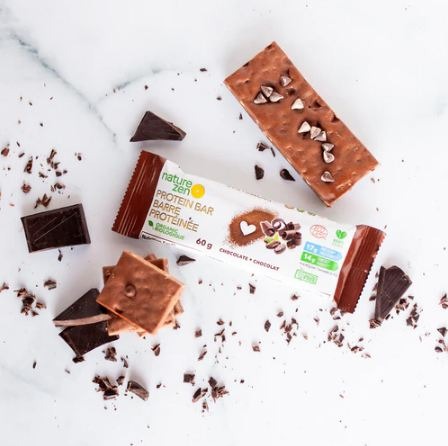When you go to grocery stores or health stores, you will often find a section of nutrition bars, or also known as snack bars or energy bars. These are bar-shaped foods that are intended to boost physical energy, and they usually contain a combination of fats, carbohydrates, and proteins, along with some vitamins and minerals. But unlike energy drinks, they do not contain caffeine.
Before, nutrition bars, especially protein bars, are considered the favorite supplement of bulky and muscular people who are always in the gym. But at the present time, many people who are aiming to stay in shape also consume them every day. This is because they see them as a healthier alternative to candy bars that are filled with sugar. In our previous article, we tackled what happens if we regularly eat protein bars. This is because more and more people are consuming them due to their health benefits.
But what exactly are nutrition bars, where did they originate, and are they really good for you? If you are also curious about these things, read on as we’re giving you the ultimate guide to nutrition bars.
The History of Nutrition Bars
Nutrition bars or energy bars are fairly new, but in the short time that they have been around, they have transcended from one identity to another. Did you know that the nutrition bars that we enjoy today started out as space food for astronauts? Yes, then they are developed to be used as fuel for athletes until they began to be consumed by everyday folks as healthy snack-on-the-go and meal replacements.
During the developing period of space travel, getting food that was both flavorful and fresh for astronauts is quite challenging. One of the most successful food items that were brought into space was Tang. From there, it made its way to breakfasts in America. It was during the time when only frozen, concentrated juice was available, and fresh juice was difficult to obtain.
Just like Tang, nutrition bars also started out in space before they made their way to Earth. The very first energy bars were called “Space Food Sticks.” These were released in the late 1960s and were produced by the Pillsbury Company. They were described as non-frozen balanced energy snacks in rod form that contains nutritionally balanced amounts of protein, fat, and carbohydrate. They come in different flavors, such as mint and peanut butter. They can also slide easily into airtight space helmets worn by astronauts.
Later on, Pillsbury decided to extend the Space Food Sticks to the public market. With this, in the 1970s, they dropped “Space” from the name. However, these food sticks were not very successful. But around the year 2000, fans of the Space Food Sticks wanted to recapture their youth, which prompted a re-release of the nutrition bars in 2006.
The very first nutrition bars that were released commercially for athletes were Power Bars, which was in 1986. Its creation inspired a whole slew of different kinds of energy bars. They were advertised towards athletes as a source of high protein and can also be used as great meal replacements for those who are on a diet.
Since Americans were increasing their snacking, the manufacturers of different nutrition bars changed the way they were promoting the food item. At the present time, nutrition bars are marketed towards everyone as healthy food for in between meals, while some can be eaten as a meal in and of itself. Today, you will be able to find energy bars in convenience stores, supermarkets, gas stations, and more. In addition to buying nutrition bars, some are even making their own at home. If you want to try it, you can read our list of Ideas for Making Your Own High Protein Low Carb Bars.
Also, here are some links to other helpful articles that you might want to check out:
The Pros and Cons of Nutrition Bars
Many people are researching whether or not nutrition bars will benefit their overall health or weight loss plan. When you think of it, it is indeed better to indulge in a good nutrition bar for lunch rather than order a high-saturated-fat burger and fries from fast-food restaurants. Nutrition bars are convenient and easy to consume. And if you read labels thoroughly before buying, they can really contribute to providing you some good nutrition. To further help you, here are some of the pros and cons of nutrition bars.
Pros:
- Nutrition bars are rich in protein: Based on nutritionists, protein is the most essential ingredient that nutrition bars contain, as it represents the key macronutrient for every individual aiming to stay in shape. It can help keep the metabolic rate in check, help build lean muscle mass and help regulate hormonal and satiety levels.
- Nutrition bars are convenient: It is truly time-consuming to always cook protein-packed and healthy meals. Also, when you carry them with you, you will need to reheat them before eating. But with nutrition bars, no preparations are needed, and they can last even without refrigeration and reheating. For busy people, this is very advantageous, especially if you want to make sure that you consume the ideal protein and other vitamins every day.
- Nutrition bars are great for nutrient intake: Nutrients are an important fuel for the body to function properly. Nutrients such as fiber, fat, and carbs work really well when consumed with protein. This helps in maintaining high energy levels, which can make you feel full, and increase your amino acid production, which helps your muscles. This is why many people who work out in gyms usually eat nutrition bars before and after their difficult routines.
Cons:
- Cost: Most nutrition bars that are good may cost a few dollars, but they can get expensive if you use them every day. But if you use them as a meal replacement for one meal a day, it still cost less compared to having a burger for lunch. It is also a lot less fat and salt.
- Excessive nutrition: If you are consuming nutrition bars just for snacks and not as a meal replacement, it is essential to find one that has less than the 30% minimum daily requirement of vitamins and minerals. It’s because eating nutrition bars might give you excessive nutrition, which can pose liver problems and other health issues.
- Might contain herbals: There are some nutrition bars that contain herbs like ephedra, bitter orange, and even caffeine from green or black tea extracts. These ingredients might affect some people’s blood pressure and heart rate adversely. Therefore, as much as possible, try to avoid these ingredients.
If you are taking certain medications, it is always a good idea to consult with your doctor first before you add anything that has vitamins and minerals to your diet. You can also check out the following articles for more information:
The Different Types of Nutrition Bars
To provide you with more ideas, here’s a list of the various types of nutrition bars and what you can expect from them:
- Energy Bars: These are usually used by professional athletes and gym-goers. These are sports nutrition supplement bars that have stimulants like caffeine and high-carb cereals. The main function of these bars is to give a quick energy fix before doing extreme activities or training.
- Protein Bars: These are supplement bars for a great source of protein boost. Compared to energy bars, these mainly provide protein that the body requires to build and maintain muscle. Protein bars are usually eaten every after a workout.
- Meal Replacement Bars: These are made in substitution for a complete meal. They usually have enough supply of protein, fats, carbohydrates, and calories.
- Weight–Loss Bars: These bars usually have fewer calories and nutrients. The main purpose of these nutrition bars is to help boost metabolism.
- Low–Carb Bars: These are made specifically for those who are on a low-carb diet. It can be consumed either to lose weight or to maintain blood sugar levels. They are also a bit high in fat and protein.
- Mega-Calorie Bars: These bars are full of calories and a wide variety of nutrients. A lot of the mega-calorie bars are marketed as healthy bars. However, most of them are the usual candy bars in camouflaged packaging.
In addition to these, you can also include granola bars and trail mix bars on the list. Just remember that when choosing nutrition bars, it is always important to read and understand the labels to get the best out of them. If you want to learn more about the different types of nutrition bars, you can check out the following articles:
Conclusion
Nutrition bars are indeed great sources of energy, fitness, and strength. However, if you are looking into using them long-term for specific purposes, you need to make sure that you are properly guided and that you choose quality ones. Making your own at home is actually one of the best options. It is also important that you still eat healthy meals and live a healthy lifestyle with proper exercise. We hope this helped you learn more about nutrition bars.




